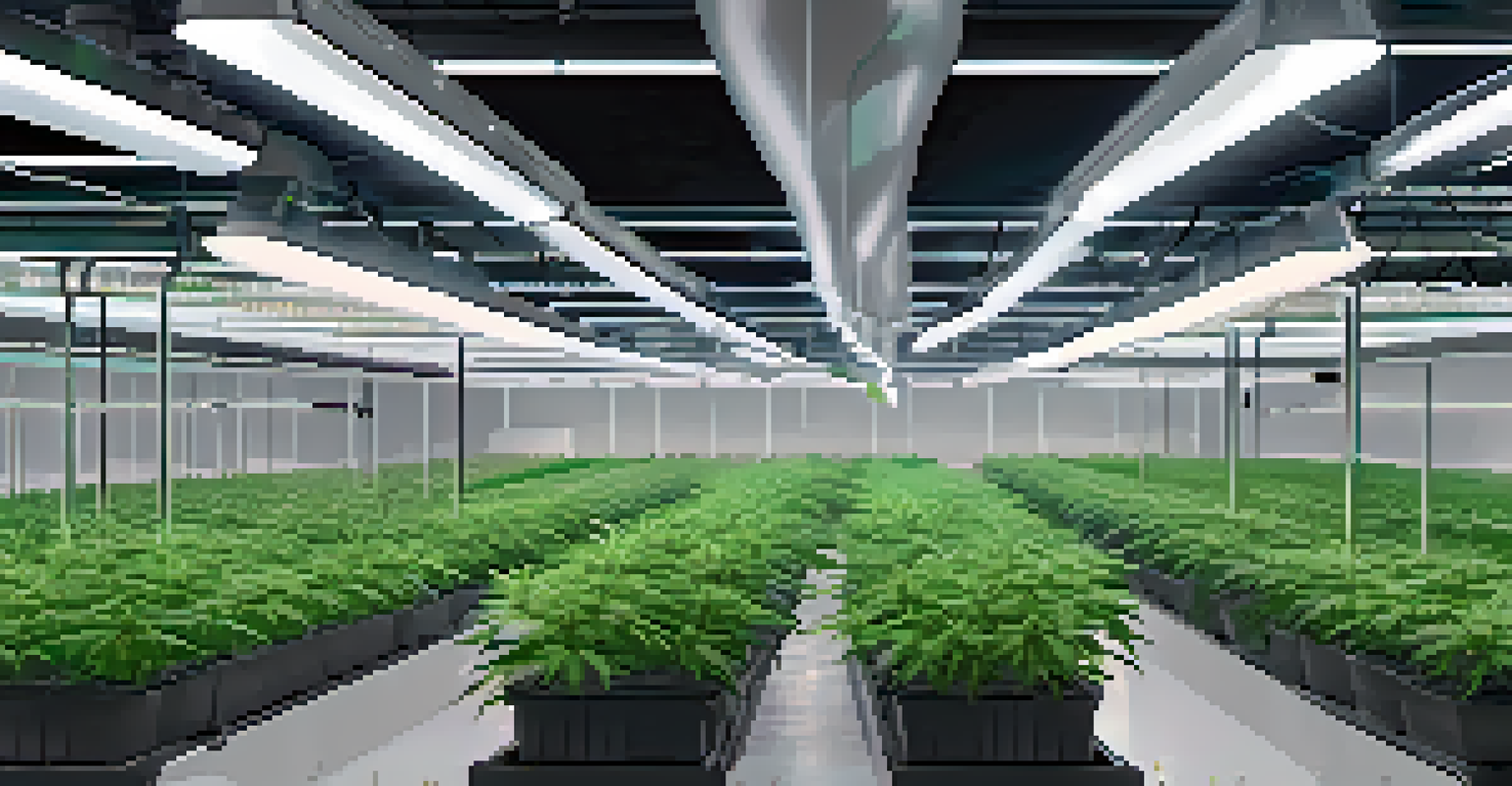Assessing Water Footprint in Cannabis Cultivation Methods

Understanding Water Footprint in Agriculture
The term 'water footprint' refers to the total volume of freshwater used to produce goods, including cannabis. It encompasses direct water use, like irrigation, and indirect use, such as water needed for the production of fertilizers. Understanding this concept is crucial for growers aiming to minimize their environmental impact while maximizing yield.
We won't have a society if we destroy the environment.
In agriculture, water is often viewed as a limited resource, especially in regions where cannabis cultivation is booming. With increasing demand for cannabis products, it’s essential for cultivators to be aware of how their practices affect local water supplies. This awareness not only helps in managing resources better but also aligns with sustainable farming practices.
By assessing their water footprint, cannabis growers can implement strategies to reduce usage, which can lead to cost savings and a more sustainable operation. This assessment can help cultivate a more eco-friendly image, appealing to consumers who prioritize sustainability in their purchasing decisions.
Factors Influencing Water Footprint in Cannabis Cultivation
Several factors influence the water footprint of cannabis cultivation, including climate, soil type, and cultivation methods. For instance, outdoor cultivation typically uses less water compared to indoor growing, largely due to natural rainfall. However, indoor farms often have more controlled conditions, which can lead to higher efficiency in water use if managed properly.

Additionally, the choice of irrigation system can significantly impact water use. Drip irrigation, for example, can minimize water waste by delivering water directly to the plant roots, whereas traditional methods like flood irrigation can lead to higher evaporation and runoff. Understanding these factors enables growers to choose the best practices for their specific situation.
Understanding Water Footprint
The water footprint in agriculture, particularly cannabis, encompasses both direct and indirect water use, highlighting the need for sustainable practices.
Furthermore, the plant's growth stage also dictates water needs, with young plants requiring different amounts than mature ones. By tailoring irrigation practices to the life cycle of the plant, growers can optimize water usage and reduce their overall footprint.
Measuring Water Footprint: Tools and Techniques
Measuring the water footprint in cannabis cultivation involves various tools and techniques that can help quantify water use effectively. One common method is using water balance calculations, which compare the amount of water entering and leaving the system. This can provide valuable insights into how much water is being consumed versus what is being replenished.
Water is the driving force of all nature.
Another approach involves the use of soil moisture sensors, which can provide real-time data about the moisture levels in the soil. These sensors help growers determine the optimal times for irrigation, reducing the risk of overwatering. By leveraging technology, cultivators can make informed decisions that contribute to a more sustainable approach.
Additionally, remote sensing technologies, such as satellite imagery, can analyze large areas of cultivation. This can help identify water stress in plants, allowing for targeted interventions that conserve water while ensuring healthy crop growth.
Best Practices for Reducing Water Footprint
Implementing best practices is key to reducing the water footprint in cannabis cultivation. One effective strategy is to adopt rainwater harvesting, which involves collecting and storing rainwater for irrigation. This not only reduces reliance on municipal water systems but also utilizes a natural resource efficiently.
Crop rotation and polyculture can also play a significant role in water conservation. By planting different crops together or rotating them, growers can improve soil health and moisture retention. This diversity can lead to more resilient plants and lower overall water needs.
Factors Affecting Water Usage
Climate, soil type, and cultivation methods significantly influence water consumption in cannabis farming, necessitating tailored irrigation strategies.
Additionally, incorporating mulch can help reduce evaporation from the soil surface, keeping moisture locked in. These practices not only safeguard water resources but also enhance the overall health of the cannabis plants, leading to better yields.
The Role of Technology in Water Management
Technology plays an increasingly vital role in managing water resources in cannabis cultivation. Automated irrigation systems, for instance, can be programmed to deliver specific amounts of water based on real-time data. This precision allows growers to optimize water usage while ensuring that plants receive adequate moisture.
Moreover, software solutions for farm management can track water usage patterns and help identify areas for improvement. These tools can analyze data over time, providing insights into how weather conditions and irrigation practices affect water consumption. With this knowledge, cultivators can make data-driven decisions.
The integration of smart sensors and IoT (Internet of Things) devices in the cultivation environment enhances monitoring capabilities. Such technology enables growers to respond quickly to changes in soil moisture and environmental conditions, ultimately helping to conserve water.
Water Regulations and Compliance for Cannabis Growers
As cannabis cultivation continues to grow, so do the regulations surrounding water use. Many regions have specific guidelines that dictate how much water can be used and the methods of irrigation permitted. Understanding these regulations is crucial for cultivators to avoid fines and ensure compliance.
In some areas, growers may be required to obtain permits for water usage, especially if they are drawing from local sources like rivers or lakes. These regulations aim to protect local ecosystems and ensure that water remains available for all users. Thus, staying informed about local laws is essential.
Technology Enhances Water Management
Innovative technologies like automated irrigation systems and soil moisture sensors are crucial for optimizing water use and promoting sustainability in cannabis cultivation.
Additionally, cultivators can benefit from engaging with local water management organizations. These entities often provide resources and support for sustainable practices, helping growers navigate the complexities of water regulations while promoting responsible water use.
Consumer Awareness and the Impact on Cultivation Practices
Consumer awareness regarding sustainable practices is on the rise, influencing how cannabis growers approach their cultivation methods. More consumers are looking for products that are environmentally friendly, prompting growers to adopt practices that minimize their water footprint. This shift not only helps the environment but can also enhance brand loyalty.
Educating consumers about the importance of water conservation in cannabis cultivation can foster a deeper connection between growers and buyers. When consumers understand the effort that goes into sustainable practices, they are more likely to support brands that prioritize eco-friendly methods.

Moreover, transparent communication about water use and sustainability efforts can differentiate a brand in a competitive market. By highlighting these practices, growers can attract a conscientious customer base that values responsible consumption.